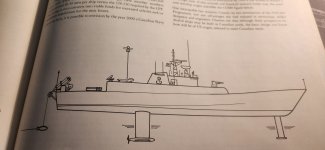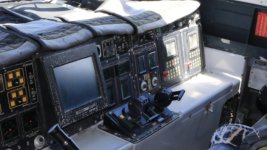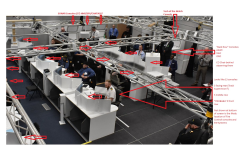Oldgateboatdriver
Army.ca Fixture
- Reaction score
- 4,120
- Points
- 1,010
Correct. And the operators of the Bras D'or had to be naval aviators trained on jetplanes that also held a watchkeeping/command certificate.

Certainly seems out of character for any Canadian government, especially a Liberal government, to be progressing so much in different areas.I also think we are getting our arms twisted.
Well, the CSC's being built in Canada is a done deal and I highly doubt we'll get a combatant to replace the Kingston's.I own a Japanese car. Maybe we should stop throwing money at the Irwins.

Bras D'or was only a demonstration of this technology, future versions wouldn't of had this type of cockpit but a bridge. The ship was built at Marine Industries Limited (MIL) in Sorel, Quebec, the primary contractor being de Havilland Canada.Not quite Kevin. The Bras D'or cockpit (it was called the cockpit -not the bridge, BTW) was just about as wide as the picture you see. No wider, so much smaller than the old Mk V. It wasn't deep either, as it could just accomodate the two pilots, then only had a small jump seat behind that you could only use after closing the access hatch.
It was conceived and designed as an airplane cockpit, controls included, as some of the equipment was similar, with similar functions. For instance, if you look to the left of the throttles, you can see a large control that looks like airplanes flaps controls. It is a trim tab system to help trim the underwater wings to generate lift. Same concept as flaps - similar controls.
All this makes perfect sense when you remember that Bras D'or was constructed by that well known shipyard: Canadair.
OGBD, it often flew faster than some of its airborne brethren of the day…Not quite Kevin. The Bras D'or cockpit (it was called the cockpit -not the bridge, BTW) was just about as wide as the picture you see. No wider, so much smaller than the old Mk V. It wasn't deep either, as it could just accomodate the two pilots, then only had a small jump seat behind that you could only use after closing the access hatch.
It was conceived and designed as an airplane cockpit, controls included, as some of the equipment was similar, with similar functions. For instance, if you look to the left of the throttles, you can see a large control that looks like airplanes flaps controls. It is a trim tab system to help trim the underwater wings to generate lift. Same concept as flaps - similar controls.
All this makes perfect sense when you remember that Bras D'or was constructed by that well known shipyard: Canadair.

You are correct on prime contractor. I meant De Havilland, not Canadair. My bad.
I don't know where you got that production models would have been different and would have had a bridge, but it's the first time I heard that

A lot of our hovercraft pilots were both aviators and mariners. One was a Master Mariner and a ex-airline pilot, who also flew interesting stuff into New Guinea.Correct. And the operators of the Bras D'or had to be naval aviators trained on jetplanes that also held a watchkeeping/command certificate.
You are correct on prime contractor. I meant De Havilland, not Canadair. My bad.
I don't know where you got that production models would have been different and would have had a bridge, but it's the first time I heard that
Interesting.Not quite Kevin. The Bras D'or cockpit (it was called the cockpit -not the bridge, BTW) was just about as wide as the picture you see. No wider, so much smaller than the old Mk V. It wasn't deep either, as it could just accomodate the two pilots, then only had a small jump seat behind that you could only use after closing the access hatch.

When I was not doing the rescue bit, my job on patrol or tranist was lookout (3 man crew, pilot, navigator and Rescue specialist) To keep ourselves sharp, we had a bit of a challenge to see if you could spot something before the navigator did on their radar. Very satisfying to beat the electronic eye. This was the early 90's so the fancy tech of today was not available to us.Interesting.
I was more meaning the layout concept. It seems the faster you go the more data you have right in front of the ‘pilots’. And less time for ‘others’ to give input.
The Mk5 had thruster controls not a yoke or wheel.
View attachment 77939

I know a few of the people who went down there, including some in the "rear" of the two forward facing rows. In the middle there are the "ORO" and "CO" participants, so I assess that those are the CO and TAO positions (apparently the RCN is changing the name, and not to the name I hoped they would go to).OK, jumping back to the theoretical Operations Room, I see a lot more consoles than others do. *Bear in mind, this is all inference based solely on my understanding of OPS rooms, and I have no actual knowledge of how this is actually being setup.
I see that there are likely 16, 3 of these being 'inferred' from the layout of the front row.
I see SONAR on the Stbd Side (as is done now)
3 Consoles in the 'Back Row' - with 3 more consoles 'back to back' with them.
Then I see the 'middle row' which has 5 Consoles, and I am guessing that the front row has another 5 consoles - possibly 6.
At the rear is the Tech of the Watch station.
Not shown in this all the other 'important' stuff that's required - Fire Control consoles and Electronic Warfare consoles along the bottom of the screen (Port Side) as is done currently as well.
I am aware that the OPS room will need to be considerably larger to accommodate the additional sensor capability that a SPY type RADAR and the AEGIS system brings to the table, so I'm not surprised at this increase.
With a 250-300km range 3D RADAR, there are 2 Radar Trackers feeding a Track Supervisor, who passes targets to the SWC/ORO.
With a larger volume of space covered by the SPY/Phased Array RADAR systems, it makes sense that there will be many more folks required to maintain the picture.
View attachment 77951
TAO? Stands for... (I can think of a few but I'm sure Asshat isn't the middle letter...I know a few of the people who went down there, including some in the "rear" of the two forward facing rows. In the middle there are the "ORO" and "CO" participants, so I assess that those are the CO and TAO positions (apparently the RCN is changing the name, and not to the name I hoped they would go to).
So, I'm not sure what the backrow will be for. I will ask some of the guys tomorrow and see if it is unclass for me to share, but I will say that it's likely that with the way AEGIS is built, we'll need two on watch SWCs, and a whole load of "NCIOPs" and "FC" types to do what only a few do on a CPF (and in some cases, what no one does on a CPF).
Tactical Action Officer.TAO? Stands for... (I can think of a few but I'm sure Asshat isn't the middle letter...)
The thing that we're missing I think is that there were a few different designs tried out. And I suspect that there might be more than one configuration in that setup. Example the back six might be a different setup than the middle five. Or that there might be some extra consoles to be added the next day to try a different organization.
We can't go full Aegis. Ship isn't designed for more than 210 pers. Flat out nowhere for them to sleep. And unlike the CPF there isn't just random space to cram them in (not that we'll have enough people anyways). We already took out some ideal bunking to jam in some equipment. So we're gonna have to figure out how to do it without all the extra people that Aegis wants.
There are more effectors as well, both EW and kinetic. I'm not sure about FC. Most of the missile we'll have are active. Will we even need a FC position if that's the case?I am aware that the OPS room will need to be considerably larger to accommodate the additional sensor capability that a SPY type RADAR and the AEGIS system brings to the table, so I'm not surprised at this increase.
With a 250-300km range 3D RADAR, there are 2 Radar Trackers feeding a Track Supervisor, who passes targets to the SWC/ORO.
With a larger volume of space covered by the SPY/Phased Array RADAR systems, it makes sense that there will be many more folks required to maintain the picture.
That is a good point.There are more effectors as well, both EW and kinetic. I'm not sure about FC. Most of the missile we'll have are active. Will we even need a FC position if that's the case?

